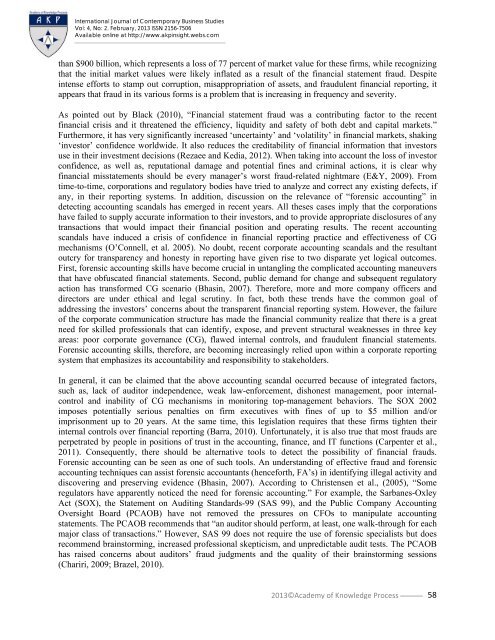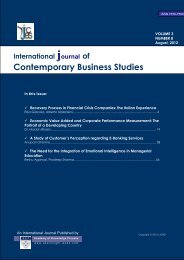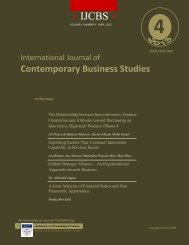Contemporary Business Studies - Academy of Knowledge Process ...
Contemporary Business Studies - Academy of Knowledge Process ...
Contemporary Business Studies - Academy of Knowledge Process ...
You also want an ePaper? Increase the reach of your titles
YUMPU automatically turns print PDFs into web optimized ePapers that Google loves.
International Journal <strong>of</strong> <strong>Contemporary</strong> <strong>Business</strong> <strong>Studies</strong>Vol: 4, No: 2. February, 2013 ISSN 2156-7506Available online at http://www.akpinsight.webs.comthan $900 billion, which represents a loss <strong>of</strong> 77 percent <strong>of</strong> market value for these firms, while recognizingthat the initial market values were likely inflated as a result <strong>of</strong> the financial statement fraud. Despiteintense efforts to stamp out corruption, misappropriation <strong>of</strong> assets, and fraudulent financial reporting, itappears that fraud in its various forms is a problem that is increasing in frequency and severity.As pointed out by Black (2010), “Financial statement fraud was a contributing factor to the recentfinancial crisis and it threatened the efficiency, liquidity and safety <strong>of</strong> both debt and capital markets.”Furthermore, it has very significantly increased ‘uncertainty’ and ‘volatility’ in financial markets, shaking‘investor’ confidence worldwide. It also reduces the creditability <strong>of</strong> financial information that investorsuse in their investment decisions (Rezaee and Kedia, 2012). When taking into account the loss <strong>of</strong> investorconfidence, as well as, reputational damage and potential fines and criminal actions, it is clear whyfinancial misstatements should be every manager’s worst fraud-related nightmare (E&Y, 2009). Fromtime-to-time, corporations and regulatory bodies have tried to analyze and correct any existing defects, ifany, in their reporting systems. In addition, discussion on the relevance <strong>of</strong> “forensic accounting” indetecting accounting scandals has emerged in recent years. All theses cases imply that the corporationshave failed to supply accurate information to their investors, and to provide appropriate disclosures <strong>of</strong> anytransactions that would impact their financial position and operating results. The recent accountingscandals have induced a crisis <strong>of</strong> confidence in financial reporting practice and effectiveness <strong>of</strong> CGmechanisms (O’Connell, et al. 2005). No doubt, recent corporate accounting scandals and the resultantoutcry for transparency and honesty in reporting have given rise to two disparate yet logical outcomes.First, forensic accounting skills have become crucial in untangling the complicated accounting maneuversthat have obfuscated financial statements. Second, public demand for change and subsequent regulatoryaction has transformed CG scenario (Bhasin, 2007). Therefore, more and more company <strong>of</strong>ficers anddirectors are under ethical and legal scrutiny. In fact, both these trends have the common goal <strong>of</strong>addressing the investors’ concerns about the transparent financial reporting system. However, the failure<strong>of</strong> the corporate communication structure has made the financial community realize that there is a greatneed for skilled pr<strong>of</strong>essionals that can identify, expose, and prevent structural weaknesses in three keyareas: poor corporate governance (CG), flawed internal controls, and fraudulent financial statements.Forensic accounting skills, therefore, are becoming increasingly relied upon within a corporate reportingsystem that emphasizes its accountability and responsibility to stakeholders.In general, it can be claimed that the above accounting scandal occurred because <strong>of</strong> integrated factors,such as, lack <strong>of</strong> auditor independence, weak law-enforcement, dishonest management, poor internalcontroland inability <strong>of</strong> CG mechanisms in monitoring top-management behaviors. The SOX 2002imposes potentially serious penalties on firm executives with fines <strong>of</strong> up to $5 million and/orimprisonment up to 20 years. At the same time, this legislation requires that these firms tighten theirinternal controls over financial reporting (Barra, 2010). Unfortunately, it is also true that most frauds areperpetrated by people in positions <strong>of</strong> trust in the accounting, finance, and IT functions (Carpenter et al.,2011). Consequently, there should be alternative tools to detect the possibility <strong>of</strong> financial frauds.Forensic accounting can be seen as one <strong>of</strong> such tools. An understanding <strong>of</strong> effective fraud and forensicaccounting techniques can assist forensic accountants (henceforth, FA’s) in identifying illegal activity anddiscovering and preserving evidence (Bhasin, 2007). According to Christensen et al., (2005), “Someregulators have apparently noticed the need for forensic accounting.” For example, the Sarbanes-OxleyAct (SOX), the Statement on Auditing Standards-99 (SAS 99), and the Public Company AccountingOversight Board (PCAOB) have not removed the pressures on CFOs to manipulate accountingstatements. The PCAOB recommends that “an auditor should perform, at least, one walk-through for eachmajor class <strong>of</strong> transactions.” However, SAS 99 does not require the use <strong>of</strong> forensic specialists but doesrecommend brainstorming, increased pr<strong>of</strong>essional skepticism, and unpredictable audit tests. The PCAOBhas raised concerns about auditors’ fraud judgments and the quality <strong>of</strong> their brainstorming sessions(Chariri, 2009; Brazel, 2010).2013©<strong>Academy</strong> <strong>of</strong> <strong>Knowledge</strong> <strong>Process</strong>58
















